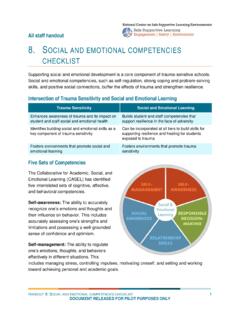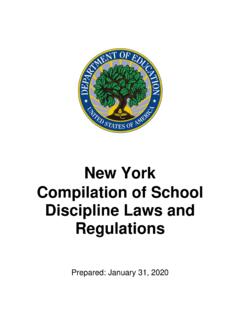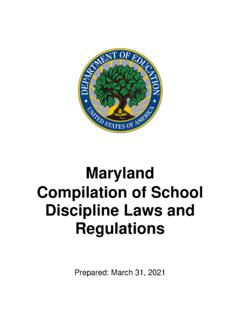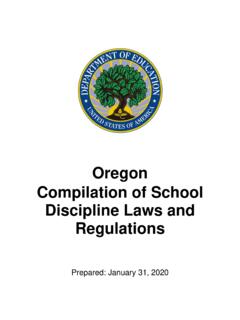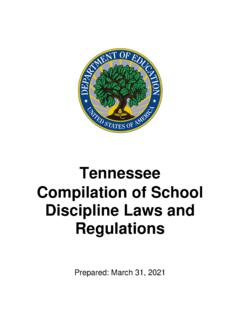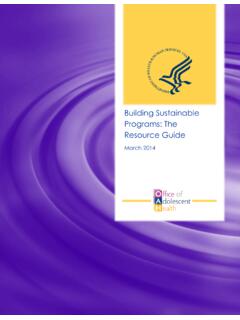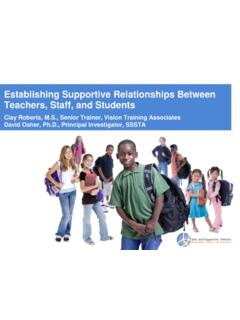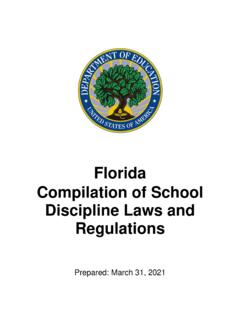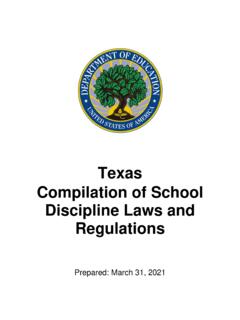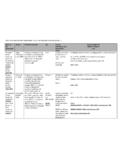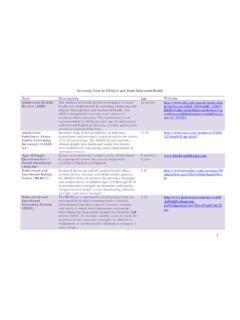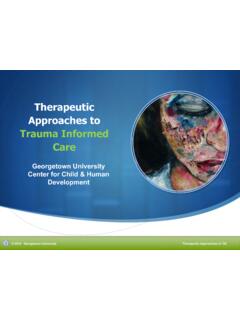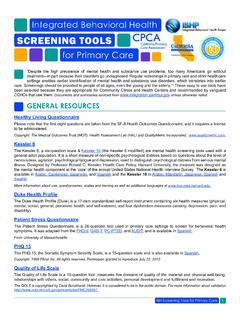Transcription of Mental Health Screening Tools for Grades K–12 - ed
1 Worksheet Overview Screening for Grades K 12 Mental Health is an important part of overall student About 20% of children and youth experience a Mental , emotional, or behavioral Health disorder, yet only roughly half of these children receive Mental Health Screening Tools can be useful for schools to understand how to identify and address the Mental Health needs of the children and adolescents they serve. Screening is termed universal when it is provided to an entire student population ( , a grade , school, district, or state) to identify students strengths and In this brief, we use the term Screening to refer to universal Screening . With the help of properly trained staff and a plan for implementation,4 Screening Tools can provide schools with data to recognize students strengths and challenges; in turn, this information can be used to inform next steps to understand and address students For example, if Screening results indicate that a student is struggling with symptoms of depression, the school can develop appropriate in-school supports and can connect the student to relevant community service providers.
2 In particular, data from Mental Health Screening Tools can inform schools universal and selective prevention efforts. Prevention strategies can assist schools to respond by promoting student well-being before symptoms worsen ( , with a referral to comprehensive assessment of an identified problem).6 Prior to using a Screening tool , it is essential that schools have (a) properly trained staff who can safely and effectively screen children and adolescents ( , at a minimum, staff who have been trained on how to administer a given Screening tool and interpret the results); (b)a system for referral and follow-up when Screening identifies aproblem that requires further attention; and (c) access to school-based and community resources to adequately address thestudent s Mental Health If schools lack these capacities,then the utility of Screening will be questionable.
3 Many expertsconsider it unethical, for example, to screen students if appropriate referral, diagnostic or treatment resources are not School Mental Health and Behavioral Health School Mental Health refers to specific emotional or behavioral needs that may be associated with a clinical condition and can be framed in terms of resilience to violence and trauma. Behavioral Health is often used synonymously with Mental Health , although it can be defined more specificallyas the conditions caused by problematic behaviors including substance use. In this brief, we use the term school Mental Health to encompass the full range of such conditions. Tiers of School Service Provision6 Universal services are provided to all students, regardless of risk level.
4 Selective prevention services are provided to students who are at risk for a disorder. Indicated services are provided to students who currently have a disorder. Mental Health Screening Tools for Grades K 12 ` 2 In such cases, schools may need to cast a wide net and consider innovative service delivery systems ( , using mobile Mental Health resources, telepsychiatry) when identifying potential , 10 Mental Health literacy ( , providing teachers and other school staff with the information and training necessary to notice unmet Mental Health needs) is vital to promote student well-being and can support timely intervention. A focus on Mental Health literacy in schools can reduce the stigma often associated with Mental Health In times of particular community anguish or trauma, such a focus can facilitate the rapid detection of critical Mental Health issues among students that indicate a need for crisis support or intervention.
5 Important Considerations for Screening tool Use To select and implement an appropriate school-based Screening tool , the National Center for School Mental Health (NCSMH) advises that schools should consider (1) what student needs are important to assess ( , symptoms of depression or anxiety; social-emotional skills); (2) whether they have an adequate system in place to conduct Screening and follow-up (including viability of Screening methods when direct, in-person contact might be unsafe or otherwise not possible); (3) how long a tool takes to administer and how much it costs ( , is it feasible?); (4) whether the tool comes with access to training or support for staff; and (5) whether the tool is reliable, valid, and evidence based ( , it has been studied and found effective for their specific population and areas of interest).
6 4 A complete NCSMH guide on Screening (see Additional Resources ) outlines key Screening implementation steps, including consent and assent processes. The following are additional considerations for schools on the use of Mental Health Screening : Screening can help inform how schools should interact with youth in ways that prevent retraumatization of students who report distressing Screening that asks students to describe distressing experiences in detail ( , events that were traumatizing) may also generate negative emotions or impacts. Schools should have supports in place to manage and minimize those impacts ( , the Screening procedure maximizes student privacy, a school counselor is available for students to talk to before or after, staff are trained on how to administer Tools in a sensitive way)
7 And that students feel safe and grounded when they leave the Research on the effectiveness of trauma Screening in schools and the availability of brief and effective universal Screening Tools for trauma is accumulating, but is still fairly Depending on which student needs they are seeking to assess, school leaders may want to consider whether the school is the most effective setting for Screening . Screening often collects sensitive data. These data are critical to identifying student needs and should be securely stored so that only staff needing the information have access to it. Furthermore, schools should limit Screening records to avoid collection of sensitive information, except as is necessary to inform next steps.
8 Schools should ensure, before undertaking Screening , that they are connected to the resources necessary to address the student needs that the Screening identifies. Such connections might take the form of in -house staffing, partnerships with school- and community-based Mental Health providers, and virtual ( , tele- Mental Health , apps) supports that students and their families can readily Not all Screening Tools have been validated to accurately screen certain populations of children and adolescents ( , refugee children and adolescents, ethnically diverse groups). Before selecting a tool , schools should investigate whether it has been studied and found to be effective with the population they intend to ,15,16 ` 3 Schools should consider using Tools that assess both student strengths and challenges.
9 In doing so, schools can focus not only on reducing student problems but also on promoting their competencies and opportunities to demonstrate resilience. In addition to Screening for Mental Health needs, schools should assess overall student learning and development to gather a more complete understanding of a student, a grade level or the student body, depending on the target of the Screening ,17 A Screening tool should be age-appropriate, and schools should consider what method of reporting ( , self, parent, or teacher) is best based on their population s self-awareness, literacy, and competence in social understanding ( , younger children typically do not have adequate self-insight for self-report, and thus in these instances, parent or teacher report is more effective).
10 7 Keeping the above considerations in mind, schools can leverage the resources described in the Additional Resources section, including: A federally funded database of no- to low-cost Screening Tools , Online courses to increase Mental Health literacy among educators, A behavioral Health service locator to target community Mental Health supports, and A best practices and tips guide to implement Screening in schools. Example Screening Tools Examples of Mental Health Screening Tools that may be appropriate for school-based use are included in Table ,19,20,21,22,23 A literature review for K 12 Mental Health Screening Tools via Google Scholar identified numerous measures across a wide range of Mental Health issues, but few of these Tools have been examined with a school-based lens ( , whether these Tools can be feasibly and effectively implemented in a school setting).
